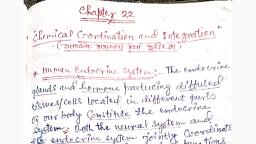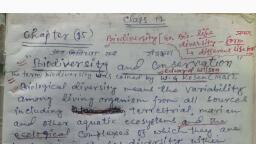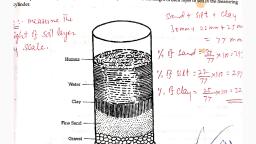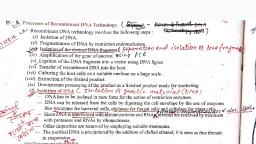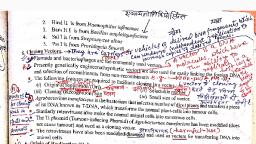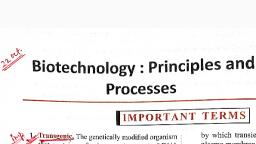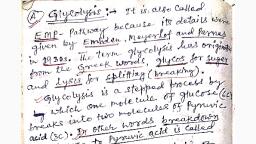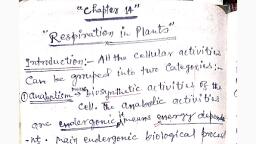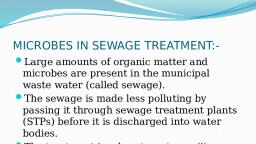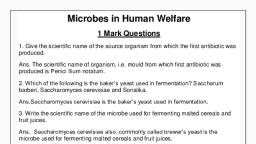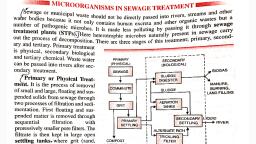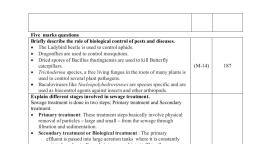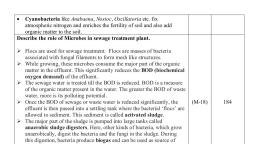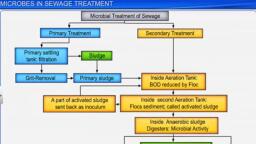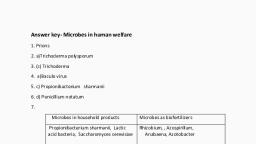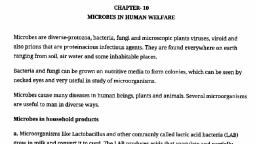Page 1 :
4Microbes, , in Sewage Trentment., The municipal waste water (called sewage) contains large amounts of organic matter and microbes, (many are pathogenic and some are other heterotrophs)., The sewage is treated in sewage treatment plants (STPs) before it is discharged into water bodies, to reduce the pollution load., The programmes like Ganga Action Plan and Yamuna Action Plan, initiated by the Ministry of, Environment and Forests of India, depend on sewage treatment before that is released into these, rivers., treatment involves two steps/stages (a) Primary treatment and (6) Secondary Treatment., , The, (a), , Primary Treatment., Primary treatment is a physical process of removal of small and large particles through, filtration and sedimentation., The first step is to remove floating objects (like polythene bags) by letting the sewage, to pass through wire mesh screens of sequentially smaller pore sizes., Then the sewage is passed into the grit chamber, where the grit is sedimented., The sewage is allowed to go into the primary settling tank, where the suspended materials, settle down to form the primary sludge., The effluent is taken for secondary treatment., , (6) Secondary Treatment., It is a hiological process, that employs the heterotrophic bacteria naturally, present in the, , sewage., , The effluent from the primary treatment is passed into large aeration tanks,, where it is, constantly agitated and air is pumped into it., This allows the rapid growth of aerobic microbes into 'flocs', which, consume the organic, matter of the sewage and reduce the biological oxygen demand, (BOD)., When the BOD of sewage is reduced significantly, the effluent is, passed into a settling, tank, where the 'flocs' are allowed to sediment forming, the activated sludge., A small part of the activated sludge is pumped back, into the aeration tank as inoculum., The remaining major part of the sludge is pumped into, anaerobic sludge digesters, where, the anaerobic bacteria digest the bacteria and fungi, in the sludge producing methane,, hydrogen sulphide and carbon dioxide, ie., biogas., (US ed as, 6F, The effluent after sccondary treatment is released jinto, water bodies like streams or rivers., , Sourte, , n., , i(Irtn, , eneri
Page 2 :
FMicrobes, , 0, , in the Production of Biogas., , Biogas predominantly contains methane (60%) and the remaining 40% is, , of CO,., , Mcthanogens like Methamobacterium produce large quantitics of methanc, along with carbon, dioxide and hydrogen, by acting on cellulosic compounds,, , are found in the following sites, (ii) rumen of cattle, () anacrobic sludge,, (ii) flooded rice ticlds and (iv) marshy places., e Cattle dung is used for the production of biogas as it contains cellulosic matcrials as well as, methanogens., The technology of biogas production was, Gas, developed in India by lndian Agricultural, Research Institute (lARI) and Khadi and, Village Industries Commission (KVIC)., Its production is as follows, -Gas-holder, () The biogas plant consists of a 10-15, Watera, (CH+CO2, Dung, Sludge, feet deep concrete tank, in which, the slurry of the dung is fed., (i) A floating cover is placed over the, slurry, which keeps on rising as the, gas is produced in the tank by the, microbial activity., (ii) The biogas plant has an outlet that, -Digester, is connected to a pipe, for removal, of biogas and supply of it to the, required place., 36, (iv) There is also an outlet to remove, 10.2 A typical biogas plant, 8Fig, the spent slurry, which can be úsed, as fertiliser., They, , (a past z stomach), , ta, , *, , p, , 3

